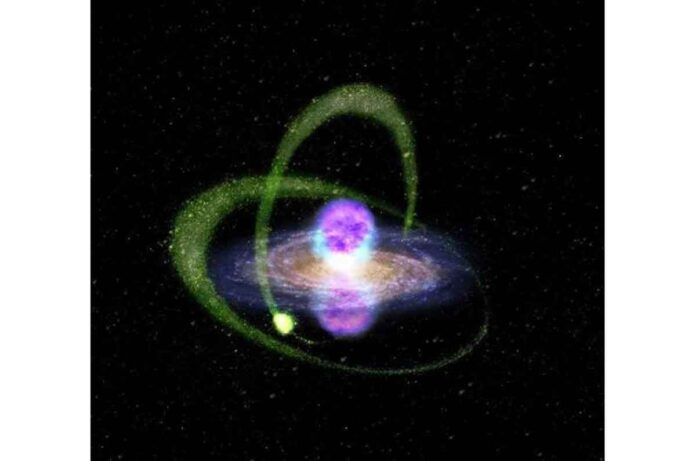According to a recent study published in Nature Astronomy, an international team of researchers has discovered a small satellite galaxy of the Milky Way filled with dark matter. However, the emissions are more likely the result of millisecond pulsars blasting out cosmic particles.
The magenta structures in figure 1 show two enormous gamma radiation bubbles that are being blown out of the galactic centre and are each 50,000 light-years across. This hourglass-shaped phenomenon was spotted with the Fermi Gamma-ray Space Telescope about ten years ago, but its origin has remained a mystery.
These radiation lobes are known as Fermi bubbles, and they are patched with a few mysterious substructures that emit very bright gamma rays. The Fermi cocoon, one of the brightest spots in the southern lobe (magnified inset in figure 2), was initially believed to be the result of previous outbursts from the galaxy’s supermassive black hole.
The Fermi cocoon is actually due to form soon, according to an international team of researchers led by former Kavli Institute for the Physics and Mathematics of the Universe (Kavli IPMU) Project Researcher Oscar Macias (currently a GRAPPA Fellow at the University of Amsterdam) and Australian National University Associate Professor Roland Crocker. They also included Kavli IPMU Visiting Scientists Shunsaku Horiuchi and Shin’ichiro Ando.
From Earth, we can observe this Milky Way satellite galaxy through the Fermi Bubbles (figure 1). It has lost most of its interstellar gas and many of its stars have been torn from its core into elongated streams as a result of its close orbit around our galaxy and previous trips through the galactic disc.
There were only a few explanations for Sagittarius’ gamma-ray emission because it was dormant, lacking both stellar nurseries and gas, including: I a population of unidentified millisecond pulsars; or ii) dark matter annihilation.

The remnants of some types of stars, many times more massive than the sun, that are in close binary systems and now emit cosmic particles due to their extremely high rotational energies are known as millisecond pulsars. The Cosmic Microwave Background’s low-energy photons collide with the electrons fired by millisecond pulsars, accelerating them to high-energy gamma radiation.
The researchers disproved the theory of dark matter by demonstrating that the gamma-ray cocoon could be explained by millisecond pulsars in the Sagittarius dwarf.
Their discovery clarifies millisecond pulsars as effective accelerators of highly energetic electrons and positrons and raises the possibility that related physical processes are taking place in other Milky Way dwarf satellite galaxies.
“This is important because experts on dark matter have long thought that an observation of gamma rays from a dwarf satellite would be a surefire sign of dark matter annihilation. Our research necessitates a reevaluation of the high energy emission properties of quiescent stellar objects, such as dwarf spheroidal galaxies, as well as their significance as prime candidates for dark matter annihilation searches “Macias said.
On September 5, specifics of their investigation were released in Nature Astronomy.

